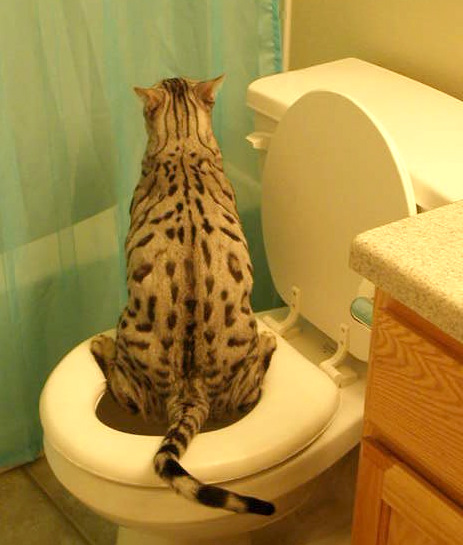The Dangers of Flushing Cat Poop Down Your Toilet - Tips for Better Handling
The Dangers of Flushing Cat Poop Down Your Toilet - Tips for Better Handling
Blog Article
Listed here down the page you can get a good deal of awesome help and advice involving Don’t flush cat feces down the toilet.

Introduction
As cat owners, it's vital to bear in mind just how we dispose of our feline buddies' waste. While it may appear practical to flush pet cat poop down the commode, this practice can have destructive consequences for both the setting and human health and wellness.
Alternatives to Flushing
Thankfully, there are much safer and a lot more accountable ways to take care of pet cat poop. Think about the complying with alternatives:
1. Scoop and Dispose in Trash
One of the most typical method of dealing with pet cat poop is to scoop it right into a biodegradable bag and toss it in the garbage. Be sure to utilize a specialized clutter scoop and throw away the waste quickly.
2. Usage Biodegradable Litter
Opt for eco-friendly pet cat clutter made from products such as corn or wheat. These trashes are environmentally friendly and can be securely disposed of in the trash.
3. Hide in the Yard
If you have a yard, take into consideration burying feline waste in a designated area far from vegetable gardens and water resources. Make certain to dig deep enough to stop contamination of groundwater.
4. Set Up a Pet Waste Disposal System
Buy a pet waste disposal system specifically developed for cat waste. These systems use enzymes to break down the waste, decreasing odor and environmental impact.
Wellness Risks
Along with ecological issues, flushing pet cat waste can additionally present health and wellness risks to human beings. Feline feces may have Toxoplasma gondii, a bloodsucker that can cause toxoplasmosis-- a possibly serious illness, specifically for expectant ladies and individuals with damaged immune systems.
Environmental Impact
Flushing cat poop presents damaging microorganisms and bloodsuckers into the water system, positioning a substantial threat to marine environments. These contaminants can adversely affect aquatic life and concession water quality.
Final thought
Liable family pet ownership extends past providing food and shelter-- it also entails proper waste administration. By avoiding purging pet cat poop down the toilet and choosing alternate disposal techniques, we can lessen our ecological impact and secure human wellness.
Why Can’t I Flush Cat Poop?
It Spreads a Parasite
Cats are frequently infected with a parasite called toxoplasma gondii. The parasite causes an infection called toxoplasmosis. It is usually harmless to cats. The parasite only uses cat poop as a host for its eggs. Otherwise, the cat’s immune system usually keeps the infection at low enough levels to maintain its own health. But it does not stop the develop of eggs. These eggs are tiny and surprisingly tough. They may survive for a year before they begin to grow. But that’s the problem.
Our wastewater system is not designed to deal with toxoplasmosis eggs. Instead, most eggs will flush from your toilet into sewers and wastewater management plants. After the sewage is treated for many other harmful things in it, it is typically released into local rivers, lakes, or oceans. Here, the toxoplasmosis eggs can find new hosts, including starfish, crabs, otters, and many other wildlife. For many, this is a significant risk to their health. Toxoplasmosis can also end up infecting water sources that are important for agriculture, which means our deer, pigs, and sheep can get infected too.
Is There Risk to Humans?
There can be a risk to human life from flushing cat poop down the toilet. If you do so, the parasites from your cat’s poop can end up in shellfish, game animals, or livestock. If this meat is then served raw or undercooked, the people who eat it can get sick.
In fact, according to the CDC, 40 million people in the United States are infected with toxoplasma gondii. They get it from exposure to infected seafood, or from some kind of cat poop contamination, like drinking from a stream that is contaminated or touching anything that has come into contact with cat poop. That includes just cleaning a cat litter box.
Most people who get infected with these parasites will not develop any symptoms. However, for pregnant women or for those with compromised immune systems, the parasite can cause severe health problems.
How to Handle Cat Poop
The best way to handle cat poop is actually to clean the box more often. The eggs that the parasite sheds will not become active until one to five days after the cat poops. That means that if you clean daily, you’re much less likely to come into direct contact with infectious eggs.
That said, always dispose of cat poop in the garbage and not down the toilet. Wash your hands before and after you clean the litter box, and bring the bag of poop right outside to your garbage bins.
https://trenchlesssolutionsusa.com/why-cant-i-flush-cat-poop/

As a reader about Don’t flush cat feces down the toilet, I assumed sharing that segment was a smart idea. Loved our blog? Please share it. Let other people locate it. We thank you for reading our article about Can You Flush Cat Poop Down The Toilet?.
Schedule An Appointment Report this page